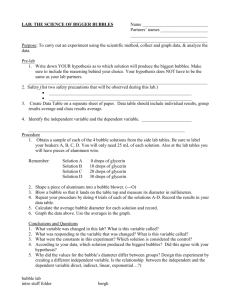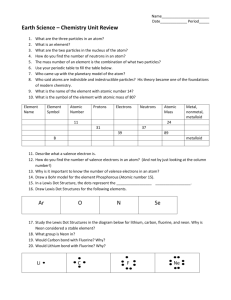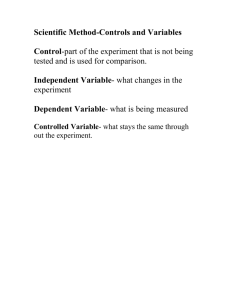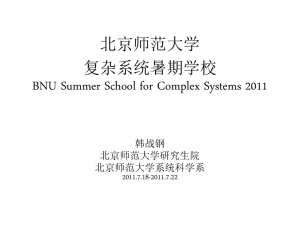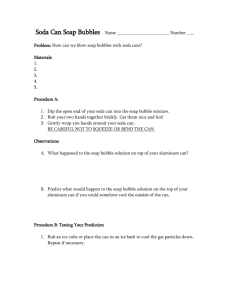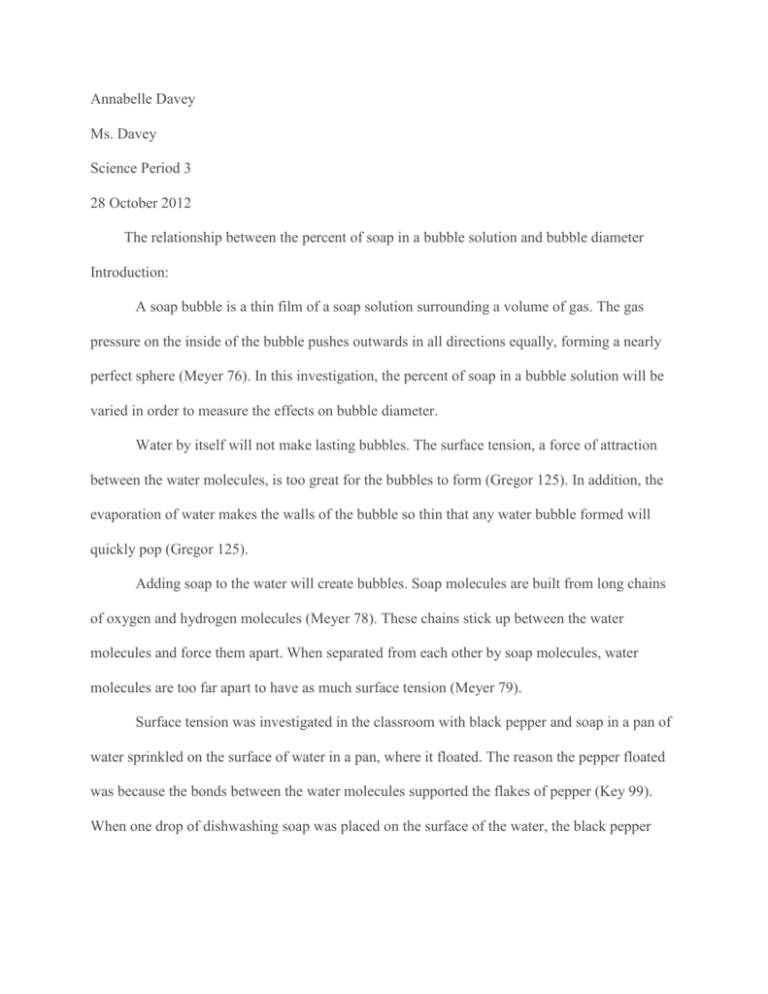
Annabelle Davey
Ms. Davey
Science Period 3
28 October 2012
The relationship between the percent of soap in a bubble solution and bubble diameter
Introduction:
A soap bubble is a thin film of a soap solution surrounding a volume of gas. The gas
pressure on the inside of the bubble pushes outwards in all directions equally, forming a nearly
perfect sphere (Meyer 76). In this investigation, the percent of soap in a bubble solution will be
varied in order to measure the effects on bubble diameter.
Water by itself will not make lasting bubbles. The surface tension, a force of attraction
between the water molecules, is too great for the bubbles to form (Gregor 125). In addition, the
evaporation of water makes the walls of the bubble so thin that any water bubble formed will
quickly pop (Gregor 125).
Adding soap to the water will create bubbles. Soap molecules are built from long chains
of oxygen and hydrogen molecules (Meyer 78). These chains stick up between the water
molecules and force them apart. When separated from each other by soap molecules, water
molecules are too far apart to have as much surface tension (Meyer 79).
Surface tension was investigated in the classroom with black pepper and soap in a pan of
water sprinkled on the surface of water in a pan, where it floated. The reason the pepper floated
was because the bonds between the water molecules supported the flakes of pepper (Key 99).
When one drop of dishwashing soap was placed on the surface of the water, the black pepper
instantly rushed to the edges of the pan. The soap had created less surface tension on the water,
allowing the pepper to spread throughout (Key 99).
In this investigation, these mechanisms will be explored further as the percent of soap in
a bubble solution is changed in order to determine the effect on soap bubble diameter. It will be
determined whether adding more soap will continuously decrease the surface tension of the
water, and allow for larger bubbles (with a greater diameter) to be created.
Statement of Purpose:
In this lab, it will be determined whether adding more soap to a bubble solution will
continuously decrease the surface tension of the water, and allow for larger bubbles (with a
greater diameter) to be created. This purpose of this lab is to determine the effect of percent of
soap in a bubble solution on the mean diameter of bubbles created.
Hypothesis:
If the percent of soap in a bubble solution increases, then the mean diameter of bubbles
created with the bubble solution will also increase because, soap molecules are built from long
chains of oxygen and hydrogen molecules (Meyer 78), and when soap is added, these chains
stick up between the water molecules and force them apart, decreasing the surface tension of the
water, allowing bubbles to form. As more soap is added, it is hypothesized that surface tension
will continue to decrease, allowing larger and larger bubbles to form.
Identification of Variables:
Independent Variable:
Percent of soap in bubble solution
Dependent Variable:
Mean diameter (mm) of bubbles created
Constants:
■ Total amount of liquid in bubble solution
■ Brand of soap
■ Person performing measurements
■ Ruler used to measure diameter of bubbles
■ Diameter of straw used for blowing bubbles
■ Humidity in room
■ Force used to blow bubbles
Materials List:
● 100 mL liquid dishwashing soap
● 300 mL distilled water
● 10 plastic drinking cups (100 mL capacity)
● Plastic drinking straw
● 100 mL graduated cylinder
● Shallow plastic tray (50 cm x 30 cm)
● Sharpie marker
● 4 stirring rods
Procedures:
1. Use the graduated cylinder to measure 90 mL distilled water and 10 mL soap and pour
into the first container. Mark this container “10%”.
2. Use the graduated cylinder to measure 80 mL distilled water and 20 mL soap and pour
into the second container. Label his container “20%”.
3. Use the graduated cylinder to measure 70 mL distilled water and 30 mL soap and pour
into the second container. Label his container “30%”.
4. Use the graduated cylinder to measure 60 mL distilled water and 40 mL soap and pour
into the second container. Label his container “40%”.
5. Mix each bubble solution gently. Different stirring rods should be used for each solution.
6. For each of the solution mixtures above, use the following procedure to test bubble
diameter:
a.
Wet the lower half of the drinking straw by lowering it into the solution
container.
b.
Pour all of the solution from the container onto the shallow plastic tray.
c.
Place the wet end of the straw into the solution and gently begin to blow the
air into the solution to form a bubble.
d.
Continue to add air to the bubble until it pops from natural causes.
7. The faint ring of foam left on the tray is the outline of the bubble. Use the metric ruler to
measure the diameter of the bubble rind in millimeters.
8. Blow two additional bubbles and measure their diameters. Measure the same part of the
foam ring on all bubbles. Record all results in the data table.
9. Drain the solution from the tray and wash all of the soap off.
10. Repeat the bubble measurement steps from steps 6-12 with each of the three remaining
solutions.
11. Repeat the experiment at least 3 more times for result accuracy.
Diagram of Apparatus:
Raw Data Table:
The effect of percent of soap in a bubble solution on the diameter of bubbles created
Observations:
10% soap solution:
Most of the bubbles were connected to smaller bubbles.
It was difficult to blow with the same force on every trial.
The bubbles moved around slightly on the tray.
20% soap solution:
Most of the bubbles were connected to smaller bubbles.
The 10% bubbles popped much faster than the 20% bubbles.
The bubbles kept popping when they touched the dry parts of the straw.
30% soap solution:
The bubbles were no longer connected to smaller bubbles.
The 20% bubbles popped much faster than the 30% bubbles.
40% soap solution:
The foam ring was thicker in the 40% solution which made it hard to measure the
ring diameter.
The trays were not washed after being drained of the 30% solution.
The 30% bubbles popped much faster than the 40% bubbles.
Data Analysis Table:
The effect of percent of soap in a soap solution on the mean diameter of bubbles created
Percent of Soap in Bubble Diameter
Mean Bubble Diameter
10%
5.00 cm
20%
11.50 cm
30%
17.75 cm
40%
23.75 cm
Graph:
Mathematical Analysis:
Mean bubble diameter was found by adding all trial data for each percent of soap, and
then
dividing by the number of trials performed (4).
For example, for the 10 % soap solution:
6 cm + 3 cm + 5 cm + 6 cm = 20 cm
20 cm/4 = 5 cm
Mean bubble diameter for 10% soap solution is 5 cm.
On the graph, percent of soap (independent variable) was plotted on the X axis, and mean
bubble diameter (dependent variable) was plotted on the Y axis.
A line of best fit was determined by using a ruler to go through the middle of the data,
ensuring that there were close to equal numbers of data points on either side of the line.
Graphical analysis was performed using this line of best fit, and can be seen below the
graph.
The calculated slope was 0.58 cm/%, which means that as the percent of soap in a bubble
solution increases by 1%, mean bubble diameter created by that bubble solution increases by
0.58 cm.
This relationship can be illustrated by the mathematical model y = 0.58 x.
This mathematical model can be used to make a prediction of bubble diameter for a soap
percent outside of the tested data. This could be done by placing a percent of soap in a soluton
into
the mathematical model in place of X, and solving for Y. For example, if the soap solution had a
soap percentage of 50%, it would be predicted the the mean bubble diameter would be 29 cm.
Evaluation:
This investigation tested the effect of different percentages of soap in bubble solutions on
the diameter of the bubbles the solution would produce. It was hypothesized that if the percent of
soap in a bubble solution increased, then the mean diameter of bubbles created with the bubble
solution would also increase. The solution with 10% soap, the lowest percentage, also had the
smallest mean bubble diameter,5.00 cm. The bubble solution with the greatest percentage of
soap, the 40% solution, had the largest mean bubble diameter, at 23.75 cm. Since the mean
values of the bubble diameter increased as the percentage of soap in a bubble solution increased,
the hypothesis was supported. The calculated slope was 0.58 cm/%, which means as the percent
of soap increased by 1%, the mean bubble diameter increased by 0.58 cm.
Inference:
There was a positive relationship between soap percentage in a bubble solution and the
diameter of the bubbles formed. According to background research, the surface tension of water
prevents bubbles from forming. The research supports the results, since the bubble diameters in
the investigation were the smallest when there was a lower percent of soap and increased
regularly as the percent of soap increased. In a solution in which the soap percent is low, the
water molecules had a greater amount of surface tension and would be close enough together to
remain bonded (Meyer 125). This made it hard to form large bubbles. As the percent of soap
increased, there were more of the long chains of hydrogen and oxygen placed between the water
molecules which kept the water molecules from forming the bonds that cause surface tension
(Gregor 74). This made it easier to form larger bubbles.
There were several sources for error in the experiment. Since there were usually several
smaller bubbles attached to the main bubble, it was difficult to decide exactly where to measure
the foam ring. Also, the tray was not rinsed off after one of the solutions was tested. This could
have caused the solutions to be mixed and the percentages of soap to have been changed. There
was a change in the width of the foam ring as the percentages increased.
If this experiment were to be repeated, the amount of side bubbles could be reduced by
stirring the solution more carefully to prevent excess foam. Also, the tray would be rinsed off
between solutions batches to prevent accidental solution mixing. The measurements taken of the
foam ring should be specifically taken on the inside surface of the ring in order to prevent errors
next time.
Relevance:
Based on the results of this experiment, another experiment could test the effect of an
even greater percentage of soap in the mixture, all the way to a bubble solution of 100% soap. It
would be predicted that there would be a limit to the size of bubbles that could be created, due to
the fact that adding too much soap would lower the surface tension of the water too much,
preventing any bubbles from forming. A bubble solution of 100% would likely not be ideal for
creating bubbles. The graph of data from this proposed lab would show mean bubble diameter
increasing as percentage of soap increase, up until a certain point, but then decreasing as soap
percentage increased past that point.
Similar experiments to the one that was conducted in this lab are probably conducted by
scientists in the development of bubbles solutions for children’s toys. The bubble solution for
these toys needs to be created carefully so that bubbles can be blown easily and maintain their
shape.
Works Cited
Frank, David V., John G. Little, and Steve Miller. “Describing Matter.” Chemical Building Blocks.
Upper Saddle River, NJ: Pearson Prentice Hall, 2005. Print.
Kalman, Bobbie. How a Plant Grows. New York: Crabtree Publishing Company, 1997. Print.
“Property.” The Free Dictionary. Farlex, n.d. Wen. O5 Nov. 2013.


